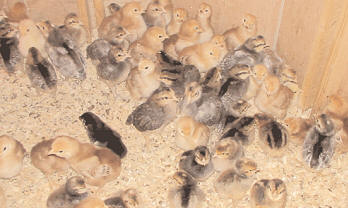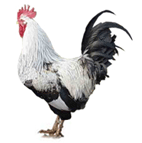|
Eggs
Hens don’t need a cockerel with them to lay eggs, only for
fertile eggs (which if collected regularly are perfectly OK to
eat). The rate of
lay will depend on nutrition, contentment, age of the bird, day
length and breed. 14 hours of daylight is the optimum day
length, and commercial producers may use lights to provide a
false dawn. Dusk should be gradual on welfare grounds, to allow
chickens time to roost.
Chickens traditionally start laying again after the winter
hiatus on St Valentines day, but you will probably get the odd
egg all year round. The proverbial china egg can help stimulate
laying. It is very important for chickens to have the correct
environment for laying eggs. It needs to be dark and reasonably
out of view.
Traditional utility breeds
are usually good layers, and you could expect perhaps 250+ eggs
a year from a Light Sussex. Some of the old breeds, those bred
for meat and the ‘fancy’ show birds are not good layers, some,
like the Brahma being known as rich men’s birds because they eat
so much and produce so little (Brahmas have other qualities
though, looks aplenty, they are one of our favourites!).
Collect your eggs at least
once a day, you don’t want birds to start sitting on a clutch
(unless you want to start breeding!) or to get a taste for eggs.
Whether to clean eggs is a matter for debate, if you do, wipe
them with a cloth dipped in clean, tepid water. Remember, eggs
are porous and will absorb smells.
Mark the date on the shell with a pencil so you use the oldest
first, and enjoy the incomparable taste of a really fresh egg.
The Moult
Once a year chickens lose their feathers (not all of them) and
grow new ones. They go rather out of sorts and off the lay, but
a few weeks will see them in a smart new outfit. It is advisable
that birds are in tip top condition prior to the moult, as the
process takes a lot out of them, so ensure your worming/parasite
control is up to date. No other action is required from the
poultry keeper though some like to add some extra vitamins or
‘poultry spice’ as an encouragement.
Flock relations
Chickens have a hierarchical social system, with the stronger,
more assertive birds having first crack at feeding, and
generally bossing the lower orders around. It is know as the
‘pecking order’. You will notice as you watch chickens the order
of precedence. This behaviour becomes particularly obvious when
new birds are introduced to an established flock: until the
order is re-established the new birds will be bullied, sometimes
quite remorselessly. It is often necessary for their protection
to segregate new birds in an enclosure within the main run until
they are accepted into the flock.

General well-being
Contented,
busy chickens are much more likely to thrive and lay well.
Chickens feed mainly by scratching the ground, then pecking
(though it’s pretty amusing to watch them chase flies) so having
an earth floor to the run, or a few inches of bark chippings or
similar, will keep them occupied and happy. Another simple
measure is to provide their greens hung up in a string bag or on
a hook so they have to reach up to get at it. If possible,
let them free range. With care, especially during the high
summer through winter, a small number of chickens will not do
much damage in a garden. On the contrary, they will eat up a lot
of pests – they love slugs – spread some very fine manure, and
be a pleasure to have around.
Keep an eye on your
flock’s behaviour, droppings, food consumption: any bird that
‘goes quiet’, has a messy tail or loses feathers should be
investigated.
Take the time to watch your birds, just for
the fun of it.
 |





